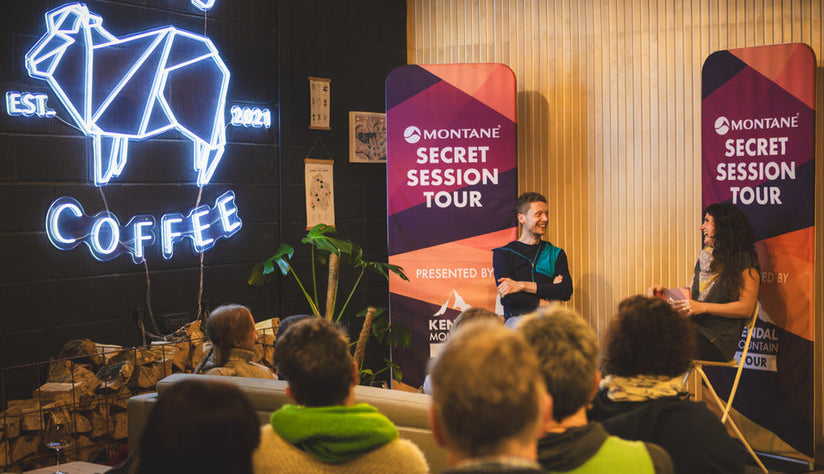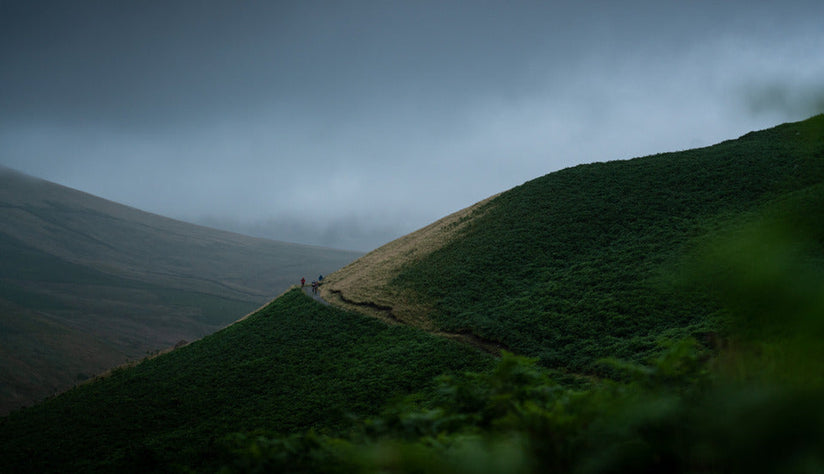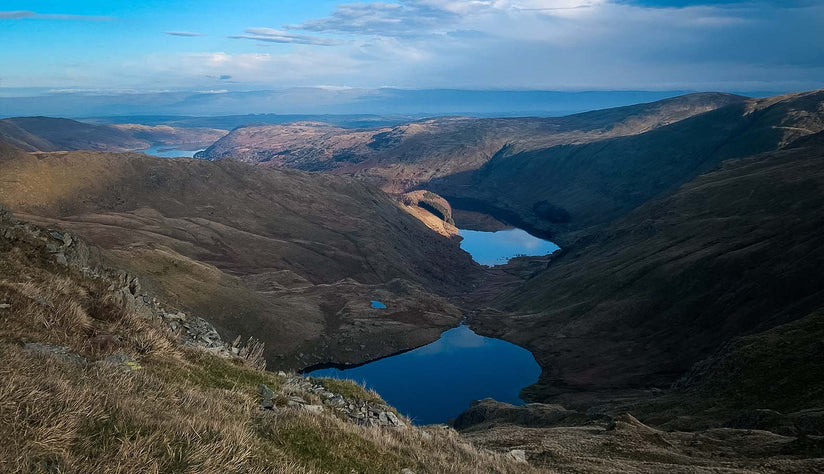Jesse Dufton is no stranger to exploring his limits. As if climbing was not difficult enough, being blind adds a whole new level of challenge and danger to the sport he loves. But Jesse has never let this stop him chasing his dreams of scaling some of the best rock on the planet. It has simply forced him to learn to trust his other senses (and his protective climbing kit) to help him navigate these environments safely.
Jesse’s latest climbing adventure saw him head to the remote and mysterious Lofoten Islands, home to some of Norway’s most dramatic jagged peaks. Joined by his climbing partner and wife Molly, as well as friend Alistair, here’s how he got on…

Unyielding elements
I listened to the eerie moan of the wind as it scythed down the valley, then the crump of impact and the strain of fabric as the tent buckled under the onslaught of the gale and its driven rain slamming into the flysheet.
The savagery of the storm fit the other-worldly nature of Lofoten. Indeed, the nearby crag alluded to the imagery of Tolkien, with climb names like Gandalf, Smeagol and Gollum. It was easy to imagine that, as in middle earth's misty mountains, it was the clash of giants that caused the maelstrom in which our tiny tent now buckled and flexed. Each successive blast threatening to shred our gossamer shield and leave us exposed to the lashing rain.
I lay there, racked by the successive blasts of over-pressure, fatalistically committed to seeing whether our shelter would survive or be torn asunder. Molly and Alistair were not gripped by the same resignation and amid the 2am twilight of an arctic summer we rose, exploiting a brief lull, to strip our camp and move to a more sheltered pitch in the next valley. A small hollow ringed by trees it warded us from the worst of the gale, and I grabbed a fitful modicum of slumber as the heavens incessantly deluged.
Leaving the tent in the morning I sloshed into the new lake that had risen to encompass us while we slept, and which was being gently supplemented by the drizzle which still fell, splattering my face. Assessing the water submerging my feet and lower shins which had begun to seep up through our tent’s groundsheet the appeal of a cafe proved irresistible.
We soaked in the cosy vibe of the café while our soaked jackets gently steamed from where they hung. We weren’t alone, the small room was filled with climbers from all over Europe similarly sheltering.
I thought back to the start of the trip. We had flown into Tromso and had a great day cragging at Brensholmen, before starting the long drive South to Lofoten, squeezing in some great climbing in the days before the elements turned against us.
Sampling unseen summits and Viking culture
Once the rain had abated, we headed to Svolvaer to climb “The Goat” a huge buttress overlooking the town which is topped by two towers which, when viewed from the town make the formation resemble a goat with 2 horns.
Usually, discrepancies between the guidebook and reality are unwelcome, but on this occasion the presence of a literal staircase, recently built by Sherpas, running up the steep hillside to the base of "The Goat" was a welcome surprise. Given how sapping travelling over broken ground can be when you can't see the rocks, roots, drops, streams, and all other manner of man traps which lie in wait, I was happy to be able to slog up the staircase, expending a fraction of the effort that would otherwise have been required.
We romped up Forsida, the most famous route up the Goat. Exquisite climbing on clean rock without a hint of polish, it was straightforward beautiful climbing following a series of cracks. Reaching the top, I declined to attempt the traditional leap between the goat’s horns, acrobatics have never been my strongest suit.
The next morning the rain returned. For somewhere that rains a lot there is not much for the drenched and despondent climber to do while waiting for dry rock. Apart from the excellent Viking Museum that is. Museums are not often that appealing when you can’t see. Racks of small objects in glass cases with boards to read isn’t accessible if you’re blind.
However, at Borg, in addition to an audio guide there was a replica Viking long house, with all manner of replica items that I was free to pick up, fondle and in the case of the drying fish and the caldron of steaming stew on the open fire to smell. I think I might have made a good Viking but was surprised how heavy and uncomfortable the helmet was. I think I’ll stick to my lightweight modern climbing helmet. On the other hand, I was amazed by how good some of the items were, especially a pair of fur mittens. Ok, I’d still prefer a nice modern pair of softshell gloves, but I could imagine those Viking mittens warding off the cold in some serious winter conditions.
We were due a day of scattered showers, so Molly and I headed to Finnvika a small sport crag with a handful of routes starting from a large sloping slab above a boulder beach. Molly and I had snuck out between the showers to try Drommen om Michaela (Michaela's Dream) a fingery little gem. It reminded me of an indoor route, the holds seemingly having been placed with the care and attention of a skilled setter. I think I must have performed my usual trick of breaking the beta and using a selection of crimps which are normally ignored. Despite it being a steep slab where an intricate foot sequence is critical, I padded to the top.
Optimism gripped us and Molly set off up the next route. Drizzle set in as she clipped the chains, and this built to a stern squall which had the route drenched by the time it was my turn. We scuttled away in search of shelter only to find that the rain was not going to be the major source of our wetness problems, as the tide had now come in and we were cut-off. Forced into an ignominious wade through thigh high sea water to return bedraggled to the car. Molly blames me, I was supposed to be watching the tide…
An iconic Lofoten climb
It is not often that climbers have more trepidation about the approach to a route than about the climb itself. However, for me there are certain routes where this is very much the case. Bare Blåbær is a prime example. Supposedly the "must do" route in Lofoten it follows a series of cracks up a huge slab in 7 pitches. Beautiful climbing on immaculate rock, the only problem for me at least is getting there. The guidebook suggests an hour's walk, but I guess it's not thinking of blind people.
It took about 2 hours on the way in for me. What makes it hard is that calling it a path would be generous. A hell-scape of boulders, trees and most importantly Jesse-snaring holes would be more accurate. My slowness meant that there were already several teams in-situ on the route when we arrived at the crag.
So, after making some new Finnish friends we got down to the very British pursuit of queuing. Turns out that this wasn't the only stereotype we would be ticking. As Alistair followed me up the third pitch gleeful at having rescued a wedged monster cam, I heard an excited "ooow" as he peered down into a deep cleft to spot a trove of lost gear. Ever resourceful, and true to his Yorkshire roots, he proceeded to "fish" with his nut-key hanging from a sling. Within a matter of minutes, he'd caught a big blue hex and a nut. Reluctantly leaving the trickier and more wedged bootie for future anglers.
His retrieval efforts meant our new Finnish friends were now passing us on the abseil line out to the side and to my bewilderment began to sing jingle bells as I set off up the next pitch. Turns out that for the continentals, the jangle of hexes or in this case torque nuts are the sign of a stereotypical Brit climber. Hence me being serenaded. What my choir sadly missed was the utility of this jangle to me.
Once we'd completed the route it was time to re-cross the hell-scape but this time we attached my torque nuts to the outside of Molly's bag, so I had a near-constant noise to follow through the maze-like minefield of pitfalls. Fair warning to all hex users out there, if you jangle them, I may follow you...
On the topic of following, it is a basic mountain lesson for most, don't just blindly follow the other people... The next day we went to try the Skiløperen, which sits on an outcrop of one of the major mountains that many tourists hike to the top of. We started the walk in and about 5mins after leaving the car, branched off the main path to head up the track leading to the crag. The large group of tourists behind us clearly were just following as they branched off too and came up behind us. Their confusion evident as the path arrived at the base of the crag and promptly stopped. We couldn't understand the exact content of their conversation, but the consternation was clear.
As I racked up at the base of the route there was a near constant train of tourists arriving at the dead-end path, I'd been an unwitting pied piper. Surprisingly, none of them attempted to follow me up the route. They were missing out, as the Skiløperen was my favourite climb of the trip, an amazing line. It follows a steep crack, with the crux being a section of obligatory jamming, before it steepens further as you reach a succession of huge flakes providing jug after monster jug as I sailed upwards bathed in very welcome sun above the huddle of lost tourists below.
After Skiløperen, we went around the corner to the next buttress, sadly losing the sun, and tried Cuckoo Crack. A forgettable first pitch brings you to a sloping ledge in a large gully with a rising diagonal crack running up the left-hand exposed wall. The sun had moved around, and we were now in shade and a fresh breeze as we waited for the party ahead to clear the pitch, yet more Finnish climbers I noted as I thought wistfully of the warm sun and huddled into my Primaloft.
Presently, the route was clear, and I climbed quickly to the probable crux, a tricky rising hand traverse on undercuts in the crack with poor footholds. Passing it quickly and consciously trying to climb fast as I knew Alistair and Molly were both cold. I realised how long the pitch was, it just kept going steady and sustained. I emptied my harness of gear, to the point where I had to get creative as I’d run out of quickdraws and almost everything in fact, even the krab I keep my emergency prussik loops on had been used. A great route and had it been in the sun it would have been hard to pick a favourite between it and Skiløperen, but for me the sunny Skiløperen takes the prize.
A final fun challenge
I'm a sucker for an immature route name, so when I found that there was a route called Butt Crack at the crag, my inner teenager took hold… I was drawn in like a moth to a flame. One of the many problems when you're blind is that you can't see the horror show you are letting yourself in for. I set off in blissful ignorance and it was only once I was committed that I found the damp streak oozing out below the route’s “buttocks”. Tiptoeing gingerly around the worst of the seepage I wiggled up into the butt crack proper. It's a flaring cleft that I needed to chimney up. Problem is, it's too tight for me to fit into nicely. With no in-cut holds or ledges to stand on I needed to smear with my feet, on one cheek, my back against the other.
As I writhed in search of upwards escape the cleft narrows and I became more stretched out, it was hard to keep my heels down to engage the smeary footholds. I feared one might slip and I would be ejected rapidly from this rock-bottom like a particularly dynamic piece of poo, but I channelled my inner Klingon, and refused to be dislodged. I figured out how to extricate my legs and scamper, relieved, to the top. Not the most elegant of routes, but it was fun!
During our time in Lofoten we had become acolytes of the YR weather oracle, with the holy tenants of the rain-radar never far from our minds. We had been granted a dry morning on our last day so time to squeeze in a short route between packing up our camping kit and starting the long drive back up North to Tromso. With my ankles now mostly a bloody mess of cuts and scabs from the numerous traps that ensnared me on the walk ins, I voted for the easiest of approaches, straight along the beach from our campsite.
Like the approach the route was good for me. Named Apa (the Ape or the Gorilla) it’s a rising diagonal fist crack up a short bulging wall. Swinging merrily from the fist jams before pulling over the final lip I resisted the urge to beat my chest in triumph and settled for a satisfied grin fitting for the end of a great trip. Despite the rain we had climbed for 10 days of our 2-week trip on some of the best quality rock I’ve ever encountered, not a hint of polish. Already my mind is turning to when Molly and I could return…
Inspired by Jesse’s story?
Hear more from our inspiring #TeamMontane climber and discover how he got on climbing in Joshua Tree National Park in California. For those eager to try some of the same routes Jesse has taken on, or looking to take their climbing to the next level this season - take a look at our men's and women's climbing kit featuring lightweight, breathable base layers and stretchy, durable trousers for ease of movement and protection as you move.















